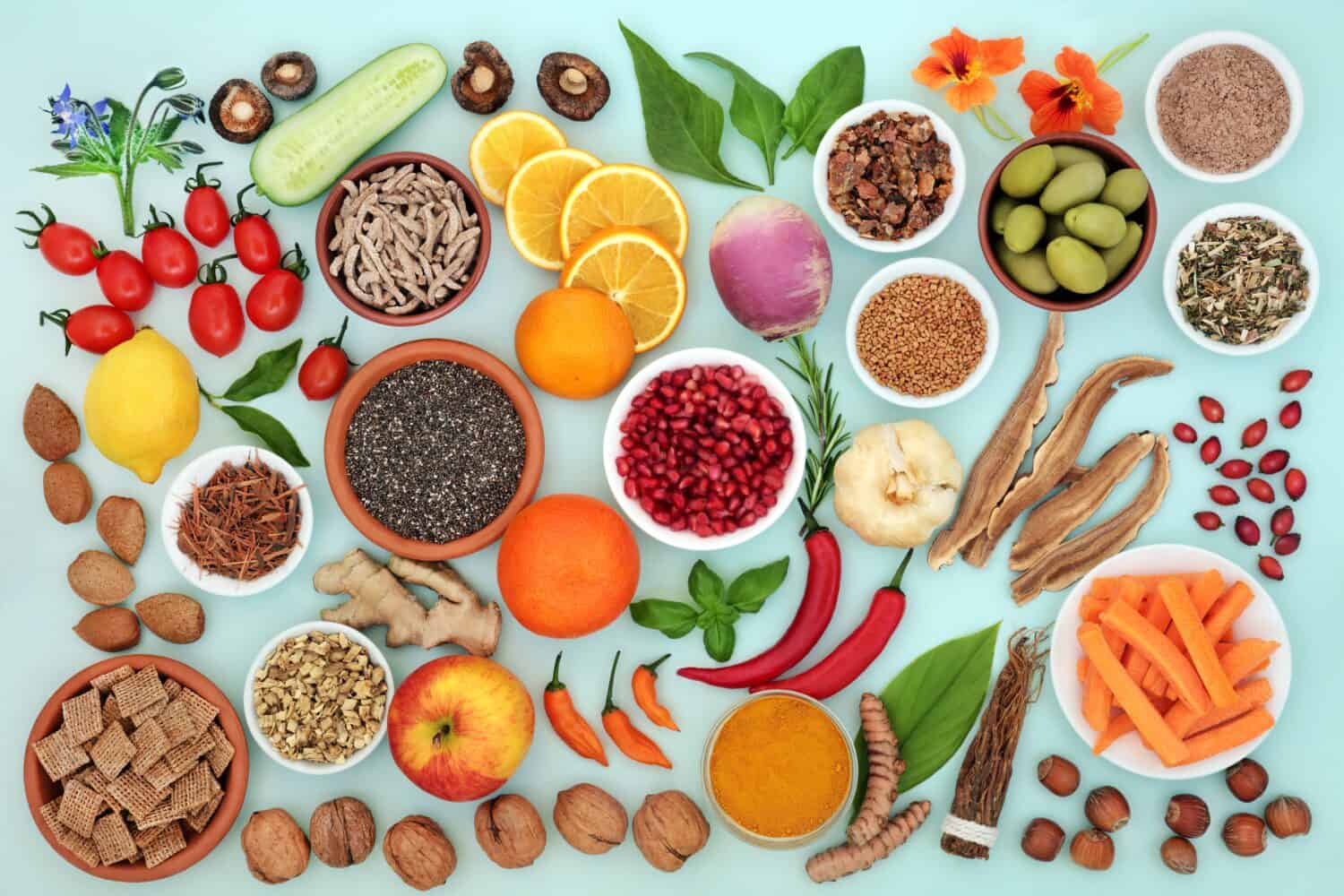Everyone can agree that eating a healthy diet has a myriad of benefits, from longevity to lower cholesterol and a better functioning immune system. But not everyone agrees on the best way to eat. There are a lot of popular diets and ways of eating, from keto and low carb to the Mediterranean and DASH diets. Recently, one diet that is getting some attention in the health and wellness world is the low glycemic diet. The low glycemic diet is focused on eating foods that are low on the glycemic index chart. But before you jump on the latest diet trend, let’s take a look at the low glycemic diet so you can decide if it might be right for you. Of course, you should always speak to your healthcare professional before starting any new eating program.
What is the Glycemic Index?
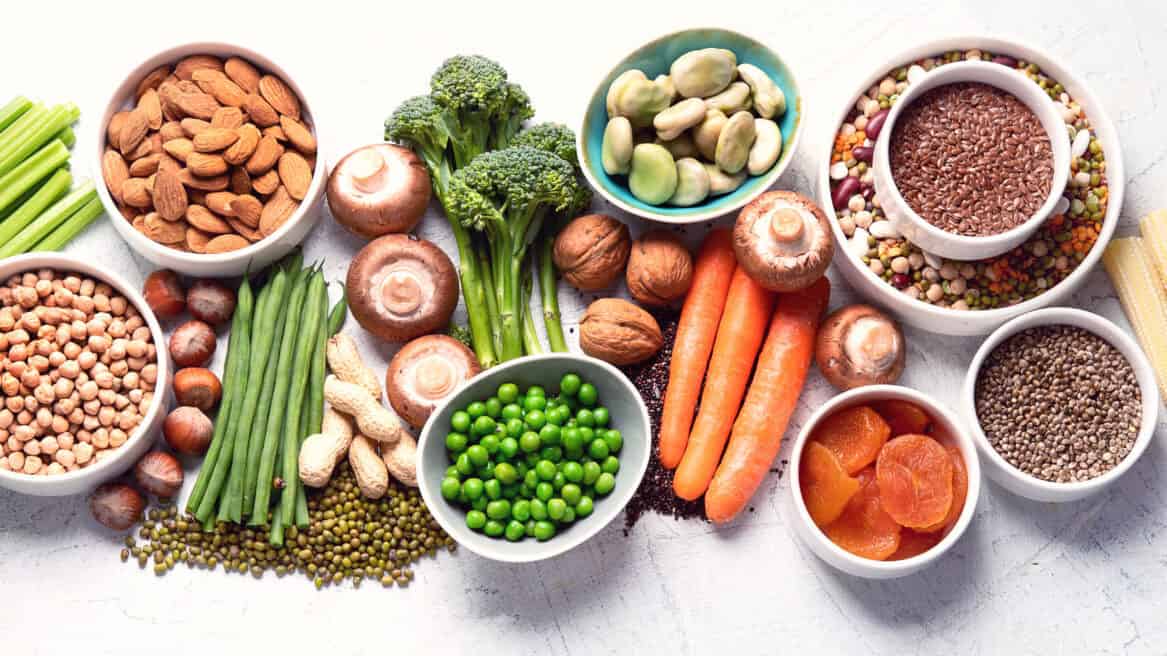
There is a mix of foods with low GI.
©Tatjana Baibakova/Shutterstock.com
The glycemic index is a system that ranks foods with carbohydrates based on how much they raise blood sugar levels. Foods that are low on the glycemic index are digested slowly, and the body can absorb them without causing blood sugar level spikes. Foods that are high on the glycemic index raise blood sugar levels quickly, causing a sugar spike or sugar high.
Foods on the glycemic index fall into three ratings:
- Low 55 or less
- Medium 56-69
- High 70 or more
History of Glycemic Index
The glycemic index was created in 1980 by physicians David Jenkins and Thomas Wolever. The research was based on creating a way of eating for people with diabetes to help control blood sugar. Their research suggested that eating low-glycemic foods may have health benefits for non-diabetics, too. The studies have been especially focused on using the GI diet for weight loss. There have been some studies that suggest it may help with weight loss, but there just isn't enough research to support those claims. Mainly because the glycemic index doesn't take into account portion size and other nutrients. Anyone who has ever been on a diet knows that portion size is a key factor in the dieting game.
Health Benefits of a Low Glycemic Diet
The ongoing debate on whether the glycemic index diet is an effective tool for weight loss is still undecided. However, there is evidence that eating a low-glycemic diet can help prevent and manage diabetes. This is good news because prediabetes is a real issue, and according to the Centers for Disease Control and Prevention, one in three American adults has prediabetes. If following a low glycemic diet can help, then it's worth knowing and understanding the glycemic index. The folks over at Healthline explain that the low glycemic diet lowers blood sugar levels, may aid in weight loss, and lowers the risk of type 2 diabetes and heart disease.
Glycemic Index Chart
The free glycemic index chart has some common foods listed so you can compare and make the right dietary choices for your own healthy eating plan and lifestyle. You will not find foods that do not have any carbohydrates on the glycemic index.
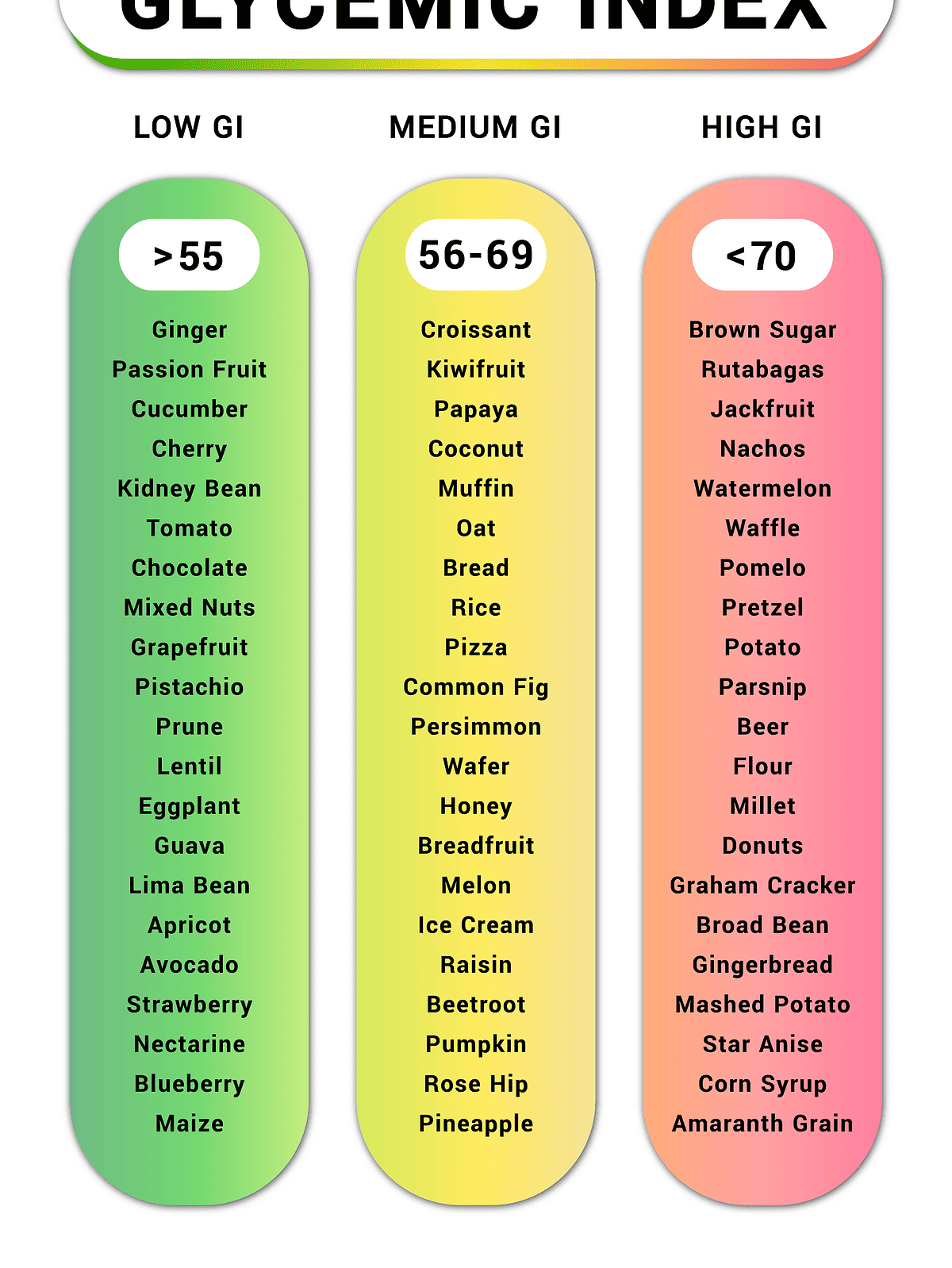
©
The factors that determine where food sits on the glycemic index are related to several things, including:
- Type of sugar
- Processing and how refined
- Nutritional make up
- Cooking method
Different types of sugar will affect where a food falls on the GI. When it comes to fruit, the ripeness of the fruit is also important because ripe fruit has more sugar. Foods that have protein and fat alongside sugar will be lower on the GI because fat and protein slow down absorption. Think of it like the difference between a protein bar and a candy bar. A candy bar is pure sugar, and a protein bar will keep you full longer because it ideally has a high amount of protein and won’t spike your blood sugar like a candy bar. The cooking method is also important for determining GI because cooking food breaks down the sugars.
How to Use the Glycemic Index Chart
On its own, the glycemic index diet is difficult to follow because people typically eat a variety of foods, making it challenging to figure out exact numbers. To solve this problem, the glycemic load or GL was introduced. The GL is based on how carbohydrates affect blood sugar. The GL is an equation of the GI and the serving size, creating a clearer picture than just the GI alone. Untangling the GI of your favorite foods and portion sizes can be confusing. Luckily, the Glycemic Index Foundation, an Australian nonprofit dedicated to helping people understand the positives and negatives of a low GI diet, has additional resources to make sense of the GI and GL.
Foods to Avoid on a Low Glycemic Diet
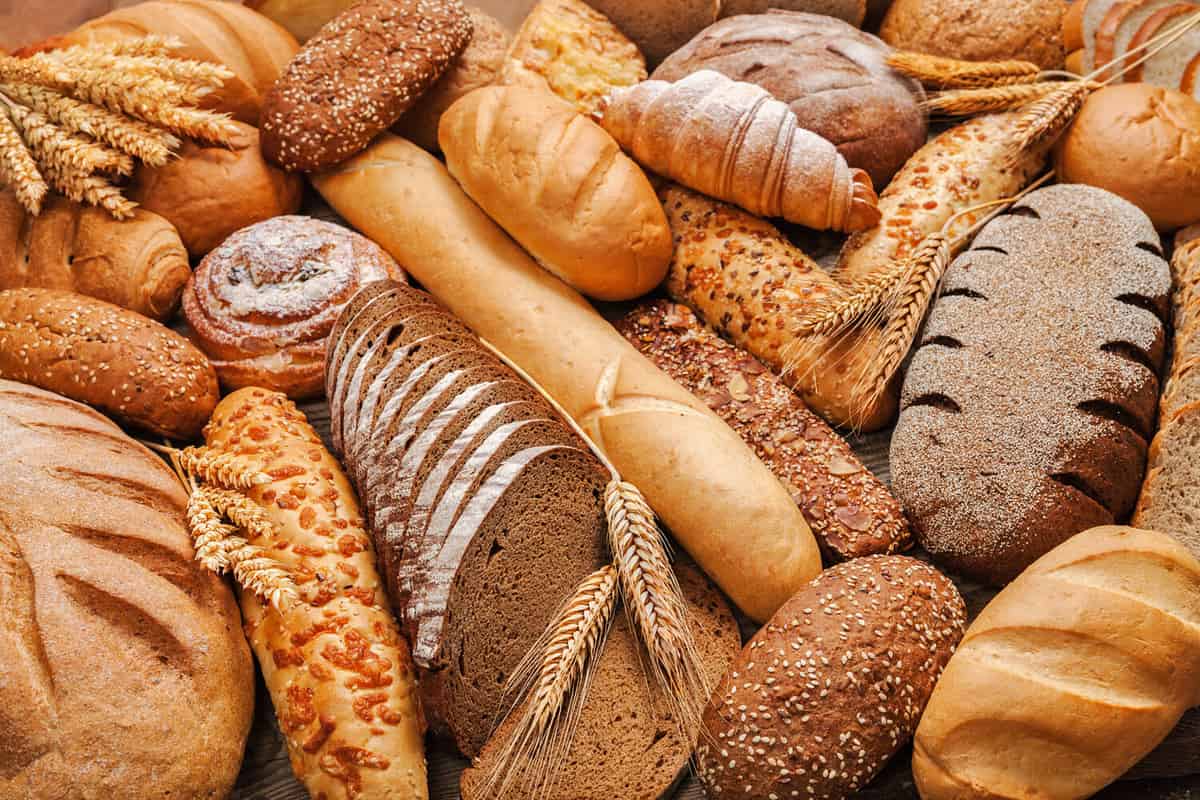
Avoid processed white flour products on the GI diet.
©Timmary/Shutterstock.com
Think of a low glycemic diet as similar to a low-carb diet, meaning you should avoid processed foods and foods with refined flour. Things like white bread, white rice, cereal, cereal bars, baked goods, crackers, potatoes, fruit juice, dried fruit, and sweetened dairy products like sweet rice milk or flavored yogurts should be avoided. The list of foods to avoid is extensive, and having a chart makes it easier.
Foods to Enjoy on a Low Glycemic Diet
The best foods for a low glycemic diet have zero or minimal carbs. For example, beef, chicken, seafood, eggs, nuts, avocado, butter, and olive oil are safe foods because they are essentially carb-free.
Luckily, the low glycemic diet does not mean you have to avoid all carbs. You can still enjoy bread, pasta, and rice as long as you stick with versions of these foods that have a low GI.
Choose bread like multigrain, rye, or sourdough. For noodles, stick with soba, rice, and vermicelli. Basmati or brown rice are safe for the low GI diet. Breakfast cereals like bran flakes and steel-cut oats are good choices. Lentils, chickpeas, and kidney beans are great swaps for rice, and you can replace starchy potatoes with sweet potatoes.
The important thing to remember when starting a new way of eating is to not get overwhelmed. Choosing the right foods and changing your diet may take a little time, so don't get frustrated. Instead, make a plan. Determine your staples for your three main meals and a couple of snacks then try and add a new recipe each week to broaden your diet. This will ensure you get all of the nutrients and not get bored eating the same thing every day. Even if you love steel-cut oats, eating a bowl every day for breakfast is a sure way to get sick of them.
Meal Ideas for a Low Glycemic Diet
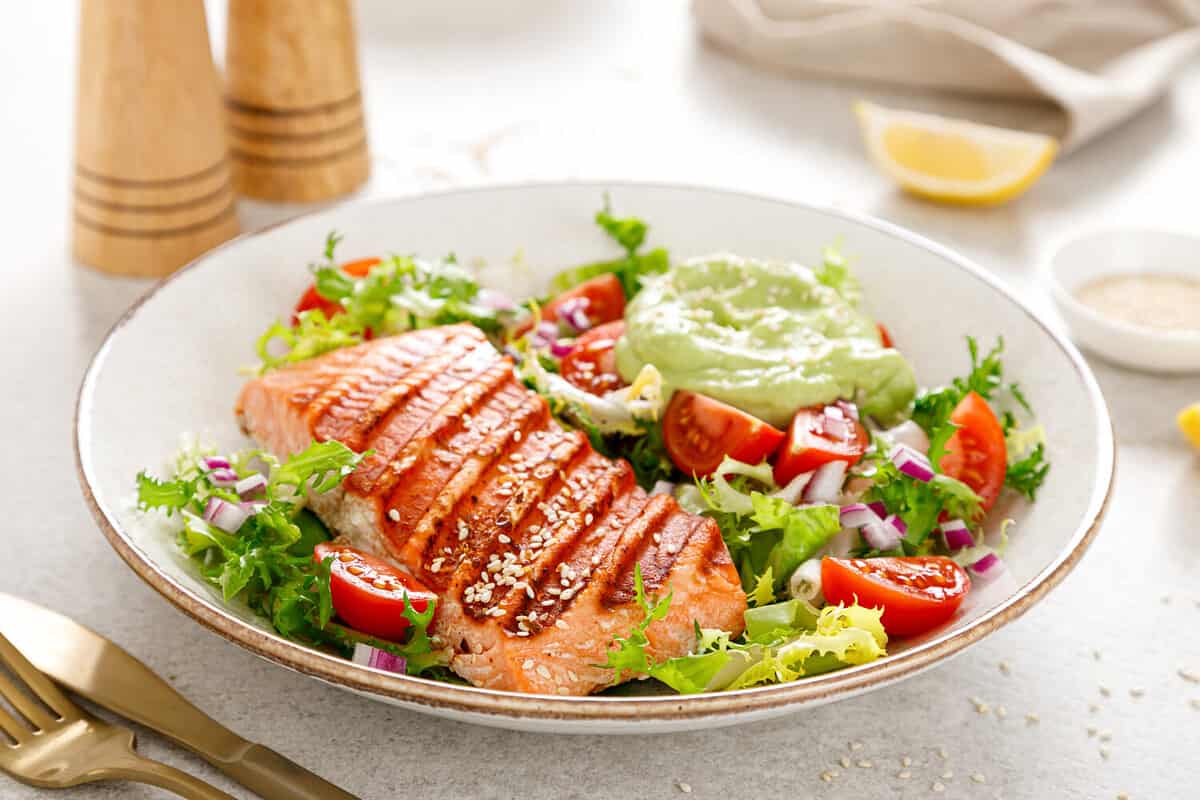
Fish and fresh veggies are great choices for a low-GI meal.
©Sea Wave/Shutterstock.com
Breakfast
- Omelet with mushrooms, spinach, and cheese.
- Poached eggs with smoked salmon and whole-grain toast.
- Avocado toast with cucumbers and tomatoes.
Lunch
- Tuna salad and quinoa.
- Vegetable soup with whole-grain toast.
- Loaded green salad with chicken, Feta, and tomatoes.
Dinner
- Grilled fish with steamed veggies and quinoa.
- Beef and broccoli stir-fry with basmati rice.
- Homemade pizza with mushrooms and spinach on sourdough crust.
Snacks
- Apple slices and nut butter.
- Carrot sticks and hummus.
- Hard-boiled egg.
Tips on Starting a New Diet
Starting a new diet can be difficult, and meal planning can help. Planning your meals and batching cooking is an easy way to get started. Batch cooking is when you make a large batch of something, use part of it, and freeze the rest. Meal planning and batch cooking are great tools to help you stick to your diet. Many foods can be made ahead and frozen. Things like egg bites, frittatas, soups, meatballs, and cooked shredded chicken are some of the things you can make ahead and freeze.
Making dietary changes can be challenging, but planning is one way to make it easier to stick to your eating plan. And the free glycemic index chart can help you understand which foods are low-GI so you can make the most of your meals.
The image featured at the top of this post is ©marilyn barbone/Shutterstock.com
